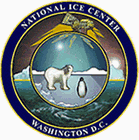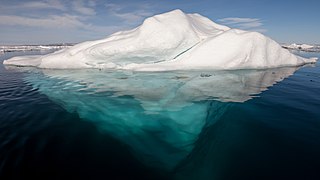Related Research Articles

The U.S. National Ice Center (USNIC) is a tri-agency operational center and echelon V command of the Naval Oceanographic Office (NAVOCEANO), whose mission is to provide worldwide navigational ice analyses for the armed forces of the United States, allied nations, and U.S. government agencies.

An iceberg is a piece of freshwater ice more than 15 m long that has broken off a glacier or an ice shelf and is floating freely in open water. Smaller chunks of floating glacially derived ice are called "growlers" or "bergy bits". Much of an iceberg is below the water's surface, which led to the expression "tip of the iceberg" to illustrate a small part of a larger unseen issue. Icebergs are considered a serious maritime hazard.

Bear Island is the southernmost island of the Norwegian Svalbard archipelago. The island is located at the limits of the Norwegian and Barents seas, approximately halfway between Spitsbergen and the North Cape. Bear Island was discovered by Dutch explorers Willem Barentsz and Jacob van Heemskerck on 10 June 1596. It was named after a polar bear that was seen swimming nearby. The island was considered terra nullius until the Spitsbergen Treaty of 1920 placed it under Norwegian sovereignty.
A hydrographic office is an organization which is devoted to acquiring and publishing hydrographic information.

The United Kingdom Hydrographic Office (UKHO) is the UK's agency for providing hydrographic and marine geospatial data to mariners and maritime organisations across the world. The UKHO is a trading fund of the Ministry of Defence (MoD) and is located in Taunton, Somerset, with a workforce of approximately 900 staff.

The International Ice Patrol is an organization with the purpose of monitoring the presence of icebergs in the Atlantic and Arctic oceans and reporting their movements for safety purposes. It is operated by United States Coast Guard but is funded by the 13 nations interested in trans-Atlantic navigation. As of 2011 the governments contributing to the International Ice Patrol include Belgium, Canada, Denmark, Finland, France, Germany, Greece, Italy, Japan, the Netherlands, Norway, Panama, Poland, Spain, Sweden, the United Kingdom, and the United States.
The Naval Oceanographic Office (NAVOCEANO), located at John C. Stennis Space Center in south Mississippi, is an echelon IV component of the Naval Meteorology and Oceanography Command (NMOC) and comprises approximately 1,000 civilian, military and contract personnel responsible for providing oceanographic products and services to all elements within the Department of Defense.

The Swedish Maritime Administration is the government agency in Sweden which provides services to the transport sector by keeping the sea lanes open and safe. The agency is to a certain degree financed through fees levied on commercial shipping.
The Arctic and Antarctic Research Institute, or AARI is the oldest and largest Russian research institute in the field of comprehensive studies of Arctic and Antarctica. It is located in Saint Petersburg.
The Australian Hydrographic Service is the Australian Commonwealth Government agency responsible for providing hydrographic services that meet Australia's obligations under the SOLAS convention and the national interest; enabling safe navigation, maritime trade and supporting protection of the marine environment. The agency, headquartered at the Australian Hydrographic Office in Wollongong, New South Wales, is an element of the Royal Australian Navy (RAN), and serves both military and civilian functions. The names Australian Hydrographic Service and the Australian Hydrographic Office are commonly abbreviated as AHS or AHO respectively.

Sailing Directions are written directions that describe the routes to be taken by boats and ships during coastal navigation and port approaches. There are also products known as Sailing Directions, which are books written by various Hydrographic Offices throughout the world. They are known as Pilot Books, because they provide local knowledge of routes and landmarks, which would typically be provided by a local marine pilot. As such, they are used frequently by naval and government vessels, who are exempted from 'Compulsory Pilotage' in many ports.
Nautical publications is a technical term used in maritime circles describing a set of publications, either published by national governments or by commercial and professional organisations, for use in safe navigation of ships, boats, and similar vessels. Other publications might cover topics such as seamanship and cargo operations. In the UK, the United Kingdom Hydrographic Office, the Witherby Publishing Group and the Nautical Institute provide numerous navigational publications, including charts, publications on how to navigate and passage planning publications. In the US, publications are issued by the US government and US Coast Guard.

The Naval Meteorology and Oceanography Command (COMNAVMETOCCOM) or CNMOC, serves as the operational arm of the Naval Oceanography Program. Headquartered at the Stennis Space Center in Mississippi, CNMOC is an echelon three command reporting to United States Fleet Forces Command (USFLTFORCOM). CNMOC's clemency is globally distributed, with assets on larger ships, shore facilities at fleet concentration areas, and larger production centers in the US.
Wilhelm Ihno Adolf von Freeden was a German mathematician and expert on navigation. He was the founder of the North German Naval Observatory. Freeden Bank bears his name.

The Federal Maritime and Hydrographic Agency of Germany is a German federal authority based in Hamburg and Rostock. With some 800 employees, the agency's tasks include maritime safety, hydrographic survey, maritime pollution monitoring, and approvals of offshore installations.

A-38 was a large iceberg that split from the Filchner-Ronne Ice Shelf in Antarctica in October 1998. Soon after formation it split into two pieces, A-38A and A-38B, which drifted westwards on the Weddell Gyre. The icebergs moved north along the Antarctic Peninsula and reached its tip in February 2003. A-38A and A-38B increased speed in open sea and grounded in shallower waters to the east of South Georgia Island in December 2003. A-38A broke up into three pieces in March 2004 and drifted north where it decayed. A-38B split into two in April, with the eastern portion, now known as A-38G, drifting north and west to decay. The remainder of A-38B remained grounded, interfering with the foraging routes of seals and penguins in South Georgia, resulting in the deaths of their young. On 20 August 2004, A38-B broke into two, with the new portion drifting north and breaking up. The remainder of A-38B continued to break up through September 2004 and had completely decayed by 2005.

The Russian Hydrographic Service, full current official name Department of Navigation and Oceanography of the Ministry of Defence of the Russian Federation, is Russia's hydrographic office, with responsibility to facilitate navigation, performing hydrographic surveys and publishing nautical charts.
The Hydrographic Institute of the Republic of Croatia is a government agency responsible for providing hydrographic and marine geospatial data for the Republic of Croatia. The institute is located in Split, and covers scientific research and development, services related to the safety of navigation, the hydrographic-geodetic survey of the Adriatic sea, marine geodesy, design and publication of nautical charts and books, oceanographic research, and submarine geology research. The Croatian Hydrographic Institute is responsible for the development of navigational safety service in the Adriatic, within the worldwide navigational safety system, and in cooperation with the Ministry of the Sea, Transport and Infrastructure, port authorities, the Croatian Navy, lighthouse authorities, and hydrographic offices of all maritime countries, following internationally agreed standards.
References
This article needs additional or more specific categories .(May 2024) |